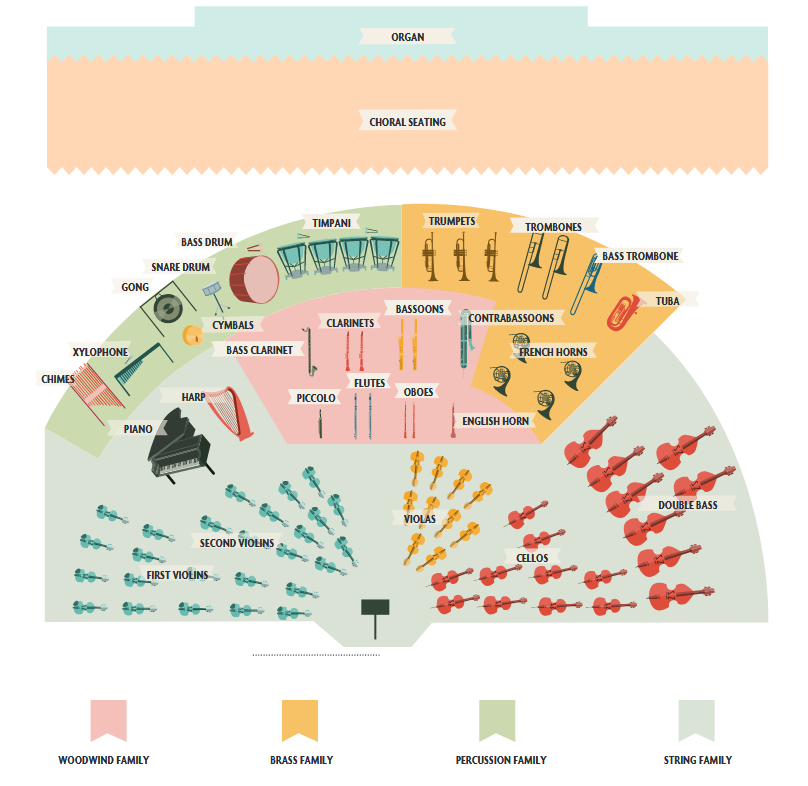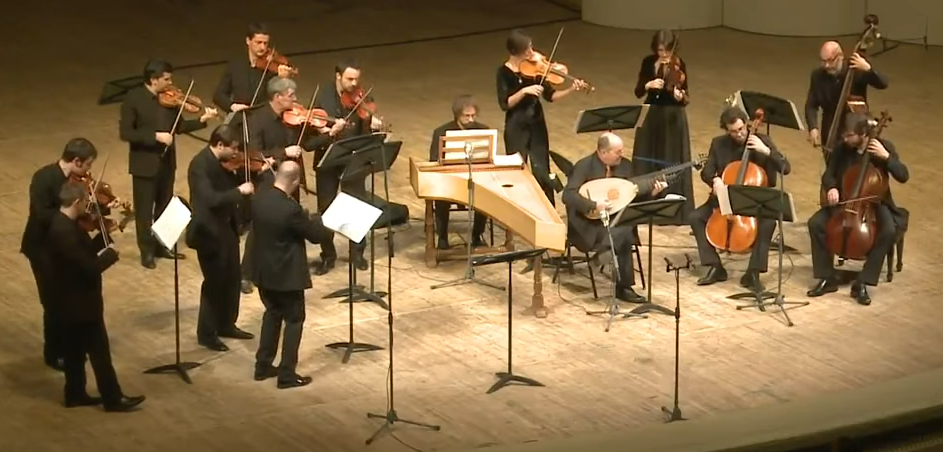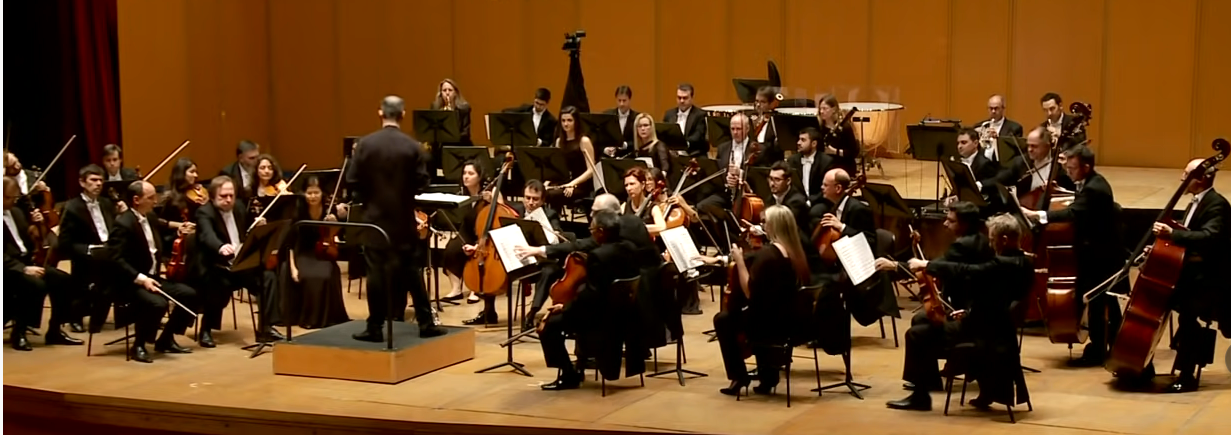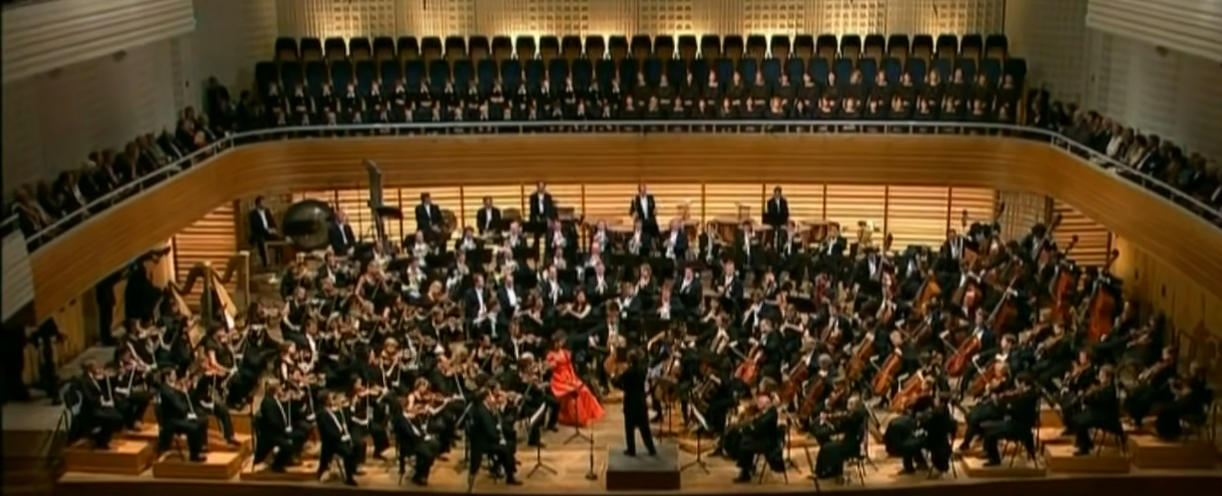2.4: The Orchestra
- Page ID
- 165585
The Orchestra.

Image taken from the Nashville Symphony Orchestra's Teacher resources page. Fair use under US law.
The orchestra is a collection of different instruments performing together. The above diagram shows a modern orchestral setup in the 20th century through today. It is important to note that early orchestras of the 17th and 18th century were much smaller than this. We'll see those in a moment.
As you can see in the above diagram, each family of instruments is placed strategically around the conductor (indicated with the little podium in the bottom-center of the image). Immediately surrounding the conductor is the string family -- remember that there is no orchestra without strings! Beginning in the Baroque Period, the string family was the primary instrument for the orchestra; only whether the composer wanted to include others would they be included! There are many string players playing the same part: "1st violins," "2nd" violins," "cello," and "double bass" (also just called "bass."). Because of this, these players are not considered soloists, as a single player could drop out and stop playing, and we would never know the difference (although the conductor would!) The leader of the first violin section is called the concert master, and is typically seated right next to the conductor. They are typically in charge of running string "sectional" rehearsals (rehearsals for just a small section of the orchestra) and also determine how the violins must bow their instrument for each piece (either moving up or down with their bow arm). This way, all of the players sound the same, and play in unison. If a composer writes a solo in the violin section, the concert master is often the one who performs it.
In the back of the strings, we see the woodwind family; this small group of winds is often called the "woodwind choir," and each player functions as a soloists, and there are often 2 players per part. You'll also notice instruments like "bass clarinet," and "English horn," which are 2 other woodwind instruments we didn't cover in the previous chapters. If you'd like to see the English horn in more detail, view this video put out by the Rochester Philharmonic Orchestra.
To the right of the winds are the French horns (remember, the blend well with the wind section) -- behind them to the right, you'll see the brass instruments.
In the back on the left, you'll see percussion instruments, and the piano and/or harp. While the harp was an addition to the orchestra in the 19th century, the piano is a much newer addition to the orchestra -- it wasn't until the 20th century where composers began to write for the piano as a member of the orchestra. Again, because there is only a single performer on each of these instruments, all percussionists (and the harpist) are considered soloists.
The Baroque Orchestra.

Screenshot of the Venice Baroque Orchestra.
As mentioned before, the Baroque (1600-1750) orchestra was fairly small, comprised of string players, a harpsichord or organ, and possibly a lute player (a lute is an older instrument that resembles a modern guitar.) The picture above contains both a harpsichordist and a lute player, seated to the right of the harpsichord player. (Interested readers can view this video of David Tayler performing Bach's BWV 999 for solo lute). With the harpsichord in the center, different string players are organized by section.
The picture above shows the Venice Baroque Orchestra playing a symphony in G minor by Antonio Vivaldi. View the video, and you'll see just how small this ensemble is; as a result, the loudness isn't nearly as much as a symphony of the later time periods, which uses and orchestra that can be up to 5-6 times the size!
Composers did write for larger orchestras; a good example of this is found in Bach's famous Mass in B minor, which incorporates a large string section, several brass, woodwind, and percussion instruments, a full choir, and solo vocalists (though this is the exception, not the rule!)
The Classical Orchestra.

Dima Slobodeniouk conducts the Orquesta Sinfónica de Galicia (Screenshot taken from YouTube)
The Classical (1700-~1820) orchestra is larger than the Baroque orchestra, and sometimes may rival the size found in Bach's B minor mass. A larger string family, and only a handful of woodwind and brass players are found in the Classical orchestra. The most common type of percussion instrument in the Baroque and Classical orchestra was the timpani, or "kettledrum," which is used to emphasize certain points in the music. Watch this video of Dima Slobodeniouk from above, and you'll see how much larger of a sound this is compared to the Vivaldi example from above. Though the orchestra still used some winds, brass, and percussion, it is not at all as large as we see in the 19th century!
The Romantic (19th century) Orchestra.

Claudio Abbado conducts Mahler's 3rd Symphony. Screenshot taken from YouTube.
As we get to the 19th century, composers writing for orchestra go all-out. Especially with composers like Gustav Mahler, it is not uncommon to see composer including 4-8 French horns alone as well as 4 trumpets, 6 trombones, multiple tubas, huge percussion ensembles, 12 or more woodwind players, and twice as many string players as we're used to in the Classical Era. Take a listen to this finale of Mahler's 3rd Symphony; you'll see just how large this orchestra can get, and what type of enormous sound can be produced!

